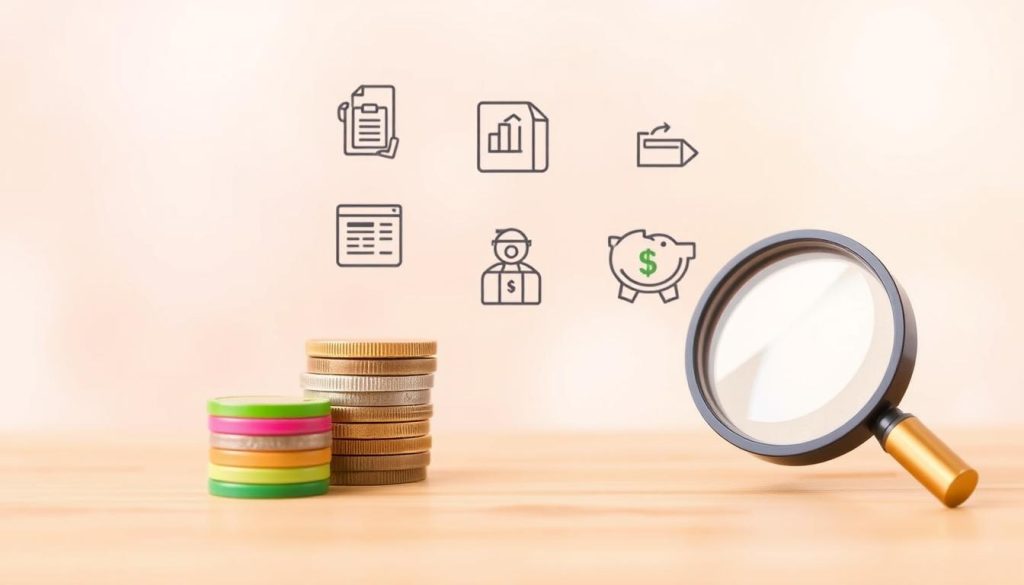Are you tired of living paycheck to paycheck? Building a safety net is crucial in today’s uncertain economy. But, have you ever wondered if there are better ways to make your money work for you?
Saving money is not just about cutting expenses; it’s about making intelligent financial decisions. By adopting savvy strategies, you can maximize your savings and achieve your long-term financial goals.
With the right approach, you can turn your savings into a significant nest egg. In this article, we’ll explore effective saving money tips and smart financial planning techniques to help you grow your savings.
Key Takeaways
- Understand the importance of saving money
- Learn how to create a savings plan
- Discover effective ways to reduce expenses
- Explore smart investment options
- Avoid common savings mistakes
Understanding Your Financial Foundation
Understanding your financial foundation is crucial for effective financial planning. It’s the cornerstone upon which successful savings strategies are built.
Assessing Your Current Financial Health
To start, you need to assess your current financial health. This involves taking stock of your income, expenses, debts, and savings. Creating a comprehensive picture of your financial situation allows you to identify areas for improvement.
- Track your monthly income and expenses to understand where your money is going.
- List all your debts, including credit cards, loans, and mortgages.
- Note down your savings and investments.
Setting SMART Savings Goals
Once you have a clear picture of your financial health, the next step is to set Specific, Measurable, Achievable, Relevant, and Time-bound (SMART) savings goals. This could be saving for a down payment on a house, a vacation, or building an emergency fund.
- Define your goal: Be specific about what you want to achieve.
- Make it measurable: Quantify your goal so you can track progress.
- Ensure it’s achievable: Make sure your goal is realistic based on your financial situation.
- Relevance matters: Align your goal with your financial priorities.
- Time-bound: Set a deadline for achieving your goal.
Creating an Emergency Fund First
An often-overlooked aspect of financial planning is creating an emergency fund. This fund acts as a safety net during unexpected events, such as job loss or medical emergencies, preventing you from going into debt.
Budgeting tips can help you allocate a portion of your income towards this fund. Aim to save 3-6 months’ worth of living expenses.
- Start small if necessary, but be consistent.
- Keep your emergency fund in an easily accessible savings account.
Smart Ways to Grow Your Savings Through Effective Budgeting
A well-planned budget is the key to unlocking your savings potential. By effectively managing your finances, you can allocate more resources towards savings and investments. Effective budgeting involves understanding your income and expenses, and making conscious decisions about how to allocate your money.
Designing a Personalized Budget Plan
Creating a budget that works for you involves several steps. First, you need to track your income and expenses to understand where your money is going. Then, you can categorize your expenses into needs and wants, and make adjustments accordingly.
The 50/30/20 Rule for Balanced Finances
The 50/30/20 rule is a simple and effective way to budget. It suggests allocating 50% of your income towards necessary expenses like rent and utilities, 30% towards discretionary spending, and 20% towards saving and debt repayment.
Zero-Based Budgeting for Maximum Savings
Zero-based budgeting involves allocating every dollar of your income towards a specific category or expense. This approach ensures that you are making the most of your money and can help you identify areas where you can cut back.
Here’s an example of how you can apply zero-based budgeting:
| Category | Allocation |
|---|---|
| Rent | $1,500 |
| Utilities | $150 |
| Groceries | $500 |
| Savings | $1,000 |
Leveraging Technology for Budget Management
In today’s digital age, there are numerous tools and apps available to help you manage your budget. From simple spreadsheet templates to sophisticated budgeting apps, technology can make it easier to track your expenses and stay on top of your finances.
Top Budgeting Apps for Americans
Some of the top budgeting apps include Mint, You Need a Budget (YNAB), and Personal Capital. These apps offer features like automated expense tracking, budgeting, and investment tracking.
Automated Tracking Systems
Automated tracking systems can help you stay on top of your finances without having to manually log every transaction. Many banks and financial institutions offer automated tracking tools that can categorize your expenses and provide insights into your spending habits.

By leveraging these tools and strategies, you can create a personalized budget plan that helps you grow your savings and achieve your financial goals.
Reducing Expenses to Accelerate Your Savings
A critical step in growing your savings is cutting back on unnecessary expenses. By understanding where your money is going, you can identify areas to cut back and allocate those funds towards savings.
Conducting a Spending Audit
To effectively reduce expenses, start by conducting a thorough spending audit. This involves tracking every purchase, no matter how small, to understand your spending patterns.
Tip: Use budgeting apps or spreadsheets to make this process easier and more accurate.
Negotiating Fixed Expenses
Fixed expenses, such as rent/mortgage, utilities, and subscription services, can often be negotiated. Contact service providers to see if they can offer any discounts or promotions.
“Negotiating with service providers can lead to significant savings. It’s a simple yet effective way to reduce your monthly expenses.”
Smart Consumption Strategies
Adopting smart consumption strategies can significantly impact your savings. This includes buying in bulk, avoiding impulse purchases, and opting for generic or store-brand products.
Avoiding Lifestyle Inflation
As income increases, it’s easy to inflate your lifestyle by spending more on luxuries. However, maintaining your current lifestyle while increasing your savings rate is a more effective savings strategy.
Discipline is key in avoiding the temptation to overspend when you have more money.
Boosting Your Savings Through Additional Income
Diversifying your income streams is a savvy strategy to accelerate your savings. By exploring various means of generating additional income, you can significantly enhance your financial stability and wealth-building capabilities.
Developing Profitable Side Hustles
Creating a side hustle is an effective way to supplement your primary income. Whether it’s freelancing, tutoring, or selling handmade products, a profitable side hustle can provide the extra funds needed to boost your savings. Consider your skills and interests when selecting a side hustle to ensure it’s both enjoyable and lucrative.

Monetizing Skills in the Gig Economy
The gig economy offers numerous opportunities to monetize your skills. Platforms like Upwork, Fiverr, and TaskRabbit allow you to offer your services on a flexible schedule. By leveraging your expertise, you can earn additional income that can be directed towards your savings goals.
Key gig economy platforms include:
- Upwork
- Fiverr
- TaskRabbit
- Freelancer
Maximizing Workplace Benefits and Compensation
Maximizing your workplace benefits and compensation is another strategy for increasing your income. This can include negotiating a salary increase, taking advantage of employer-matched retirement accounts, or utilizing other company benefits such as professional development opportunities or flexible work arrangements.
Tips for maximizing workplace benefits:
- Negotiate your salary based on industry standards
- Contribute to employer-matched retirement accounts
- Utilize company benefits such as professional development courses
Conclusion: Transforming Savings into Lasting Wealth
By implementing the strategies outlined in this article, individuals can set themselves on a path to financial stability and growth. Effective wealth-building techniques, such as budgeting and reducing expenses, lay the groundwork for a secure financial future.
Creating a savings plan tailored to your needs is crucial. This involves not only setting aside a portion of your income but also exploring retirement savings plans to ensure a comfortable post-work life.
Consistency is key when it comes to saving. By making informed financial decisions and staying committed to your goals, you can transform your savings into lasting wealth. Start or continue your savings journey today, and watch your financial health flourish over time.

Leave a Reply